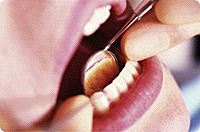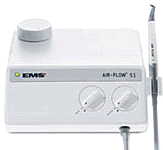Parodontology
 Parodontitis is a bacterial infection which primarily damages the tissues surrounding and fixing the teeth, the gingiva, the desmodontium and the bone.
Parodontitis is a bacterial infection which primarily damages the tissues surrounding and fixing the teeth, the gingiva, the desmodontium and the bone.
 Factors that might increase the likelihood of the disease are: neglected teeth, lack of appropriate oral hygiene, bad fillings and dentures, smoking (20 fold increase), diabetes, decreased immune response and genetical background. The baceria causing the infection can be detected in a healthy mouth cavity as well, though only in a small quantity. Pellicle and calculus may cause a rapid ncrease in their numbers and can damage the tissue seriously, by producing a great amount of toxin. Initial symptoms are: bleeding gingiva, bad breath, pain and later on tooth drifting, tooth mobility, gingival abraison, purulent bags. The treatment includes several stages and might require a long term cooperation from the patient.
Factors that might increase the likelihood of the disease are: neglected teeth, lack of appropriate oral hygiene, bad fillings and dentures, smoking (20 fold increase), diabetes, decreased immune response and genetical background. The baceria causing the infection can be detected in a healthy mouth cavity as well, though only in a small quantity. Pellicle and calculus may cause a rapid ncrease in their numbers and can damage the tissue seriously, by producing a great amount of toxin. Initial symptoms are: bleeding gingiva, bad breath, pain and later on tooth drifting, tooth mobility, gingival abraison, purulent bags. The treatment includes several stages and might require a long term cooperation from the patient.
The primary aim of the treatment is to cure the infection and diminish every possible circumstance that may lead to infection and to preserve the healthy state.As the destoyed tissues are ruined for good and the body is not able to reproduce tissues identical to the original one, the area needs to be healed by means of an operation eg.: using a bone substitute. It is important to note that the quantity of the receeding gingiva is defined by the bone left after the paradontal damage and it is not possible to reconstruct the original line of the gingiva.
The possible steps of curing paradontal damage:
- removing calculus
- curettage under the gingiva
- check up on oral hygiene, introducing special equipment
- splinting (fixing mobile teeth)
- reparative operation (bone substitute)
- after treatment (regular check up)
In order to achieve success and preserve their health, the patient needs to maintain adequate oral hygiene, pellicle free teeth.